International Relations, India and its Neighbourhood Relations
Why in news : Recently face-off between Indian and Chinese Army at Eastern sector of Line of control (LAC) which led to physical scuffle at Yangtse, TAWANG SECTOR.
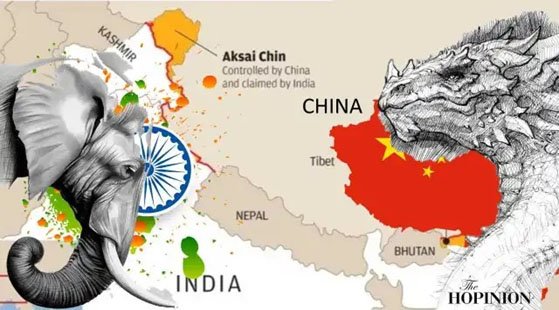
(CREDITS: The Hopinion)
CONTEXT :
- The Chinese army tried to enter the Indian side of border and change the status-quo on LAC unilaterally in TAWANG SECTOR in ARUNACHAL PRADESH, which was contested back by Indian army firmly.
- This led to face-off and physical scuffle between the two armies. Later on the development, Chinese army (PLA) returned to their posts. The Yangtse posts are repeatedly jostled by PLA.

(CREDITS: The Indian Express)
GEOGRAPHY OF INDO-CHINA BORDER
India shares 4000km long border with China, which can be classified into three sectors vis-a-vis WESTERN, MIDDLE AND EASTERN SECTOR.
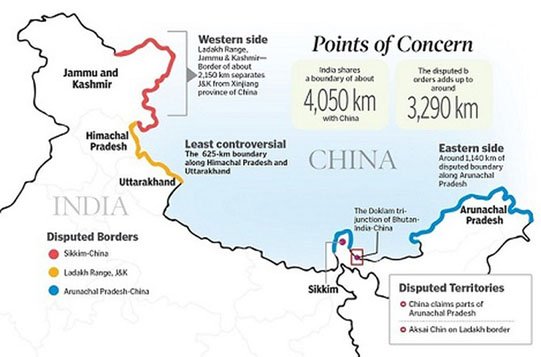
WESTERN SECTOR
- This sector of about 2512kms long between LADAKH and XINJIANG province of CHINA.
- The territorial dispute in the western sector is over Aksai Chin. India claims it as part of erstwhile Kashmir, while China claims it is part of Xinjiang.
- The dispute is due to failure of British government to demarcate the legal boundaries between the both countries.
- During British rule two arrangements named JOHNSON LINE 1865 AND McDonald line 1893 were proposed.
- The JOHNSON line shows Aksai chin in India’s control while McDonald shows it in China’s control which became the cause of dispute since then.
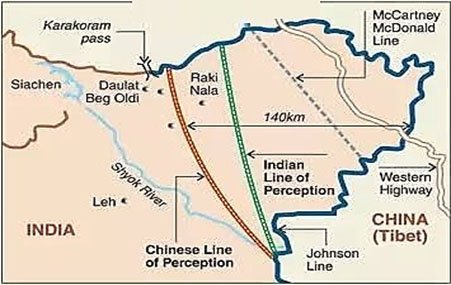
(CREDITS: The Indian Express)
- At present, Line of Actual Control (LAC) is the line separating Indian areas of Ladakh from Aksai Chin. It is concurrent with the Chinese Aksai Chin claim line.
EASTERN SECTOR
- In the eastern sector, India shares a 1140 km boundary with China.
- The boundary line is called McMahon Line.
- The majority of the territory of Arunachal Pradesh is claimed by China as a part of Southern Tibet.
- China considers the McMahon line illegal.
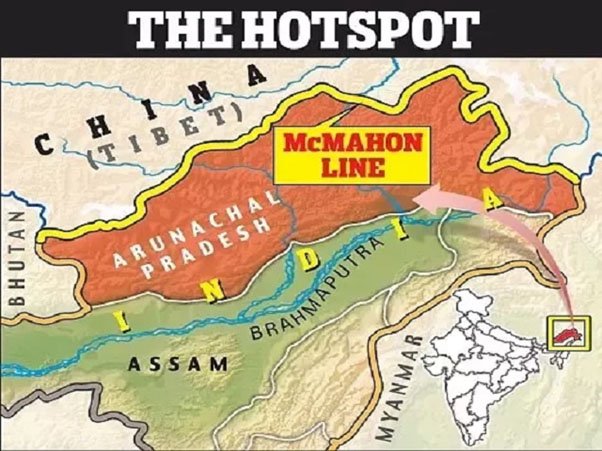
Middle Sector :
- In the middle sector, India shares about 625km of the border with China.
- This is the least disputed sector between the two nations.
- The states of Himachal Pradesh and Uttarakhand touch the border with Tiber in this sector.
DISPUTED AREAS ALONG LAC
There are several disputed areas along the Line of Actual Control (LAC), including in Himachal, Uttarakhand and Sikkim.
Disputed areas in LADAKH
- Pangong Tso lake
- Galwan Valley, where Shyok and Galwan rivers meet
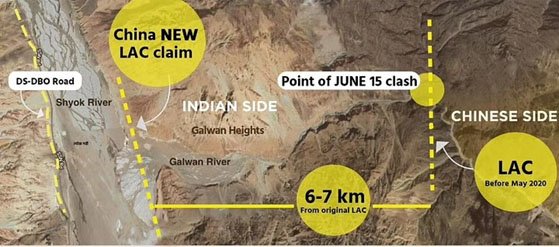
- Daulat Beg Oldi (DBO), a key northern region close to the Karakoram Pass.
- The Hot Springs-Gogra area of the LAC
- Demchok which is close to the southernmost part of the LAC in Ladakh.
- Chushul, located on the southern bank of Pangong Tso Lake, has an airstrip and is near Rezang La pass on the LAC.
- Spanggur Gap along the LAC has roads leading to it from either side. India’s Chushul-Demchok road in the area is a critical communication link.
- Samar Lungpa
- Trig Heights
- Chumar
- Dumchele
- Kongka La
Disputed areas in Himachal Pradesh
- Shipkila
- Kaurik
Disputed areas in Arunachal Pradesh
- Sumdorong Chu
- Asaphila
- Longju
- Dichu
- Yangtse
- Fish Tail-1 & 2 in Dibang Valley
- Lamang
- Namkha Chu
BORDER DISPUTE AGREEMENTS AND RESOLUTION MECHANISM
India China border related agreements:-
1988 : India-China Joint Working Group on the boundary question Trade
1991 : Memorandum on the Resumption of Border Trade
1992 : Protocol on Entry and Exit Procedures for Border Trade
2003 : Memorandum on Expanding Border Trade Confidence building measures
1993 : Border Peace and Tranquility Agreement, 1993
1996 : Agreement on Military Confidence Building Measures
2005 : Protocol for the Implementation of Military Confidence Building Measures
Political measures
2003 : Declaration on Principles for Relations and Comprehensive Cooperation
2005 : Agreement on the Political Parameters and Guiding Principles for the Settlement of the India-China Boundary Question
2012 : Agreement on the Establishment of a Working Mechanism for Consultation and Coordination on India-China Border Affairs
2013 : Border Defence Cooperation Agreement
2020 : 5 – point statement
- In 1993, Agreement on the Maintenance of Peace and Tranquility along the Line of Actual Control (LAC) on the India-China Border Areas was signed to bring stability and substance in bilateral ties.
- In 2008, two countries have also extended their strategic and military relations.
- Recently, Five points of agreement was also set forth after the sixth round of talks between the senior military commanders.
- Both sides should take guidance from the series of consensus of the leaders
- Current situation in the border areas is not in the interest of either side.
- Both sides shall abide by all the existing agreements and protocol on China-India boundary affairs,
- Both sides have agreed to continue to have dialogue and communication through the special representative mechanism on the India-China boundary question.
- Both have decided to conclude new confidence-building measures to maintain peace and tranquility.
REASONS FOR CHINA’S AGGRESSION
- The Yangtse incident came days after China said that the joint India-US military exercise Operation Yudhabhyas had violated the terms of the 1993 and 1996 border agreements.
- Belt Road Initiative : India has objected this, since its inception on grounds of violating its sovereignty pointing to China Pakistan Economic Corridor.
- China has expressed concerns about Indian military and economic activities in the disputed South China Sea.
- China’s flexing of muscles and big brother attitude towards other South Asian nations to ensure its dominance in region.
- China’s 5-finger policy that considers Tibet to be China’s right hand palm, with five fingers on its periphery: Ladakh, Nepal, Sikkim, Bhutan, and North-East Frontier or Arunachal Pradesh.
- China was internationally being blamed for being negligent and opaque about the corona virus, its origins and spread and thus China had to respond aggressively to convince its people of its powers.
- India getting close to USA strategically.
- China also been hostile to Vietnam, Philippines, Indonesia and Japan in recent weeks and months and this incident is a part of the new Asian geopolitics.
HOW INDIA CAN PREVENT SUCH SKIRMISHES AT LAC
- India and China should seek an early settlement of the border issue, before the final settlement of the boundary question is reached we should jointly maintain peace and tranquillity in the border areas.
- There is need to increase the frequency of talks at highest levels multilateral meets such as East Asia Summit (EAS), the Shanghai Cooperation Organisation (SCO), Conference on Interaction and Confidence-Building Measures in Asia (CICA), BRICS and G-20.
- Regular commander level talks on all sectors will ensure peace and tranquility on borders.
- Trust deficit is a critical issue in Sino-Indian bilateral relations. In order to solve this problem, track II diplomacy can play a more active role.
CONCLUSION
- India-China should follow the principle of the PANCHSHEEL (Five Principles of Peaceful Coexistence) and must strengthen coordination on international and regional affairs through more regular and high-level political engagement.
- With increasing physical connectivity and economic co-ordination, both countries can act as an engine of growth for the entire South Asia.
SYLLABUS : GS 2, International Relations, India and its Neighbourhood Relations.

